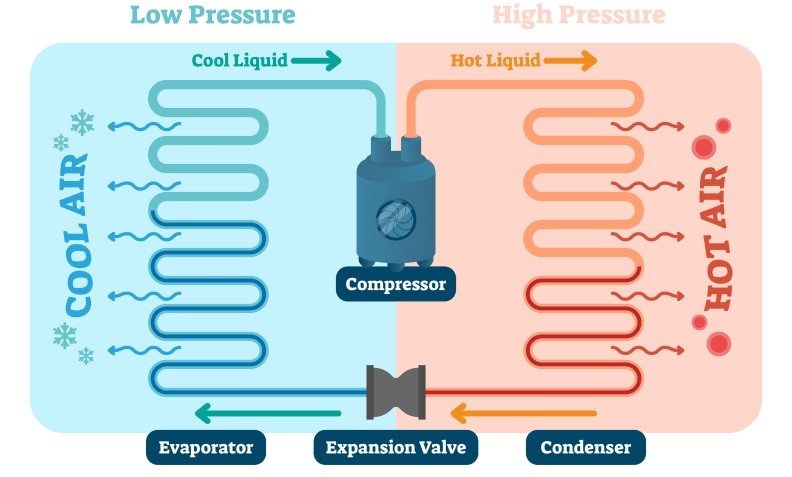
Staying cool and comfortable during hot weather is essential for our well-being. Air conditioners have become indispensable appliances, providing relief from sweltering temperatures and creating a pleasant indoor environment. But how exactly do these devices work their magic? This article delves into the science behind air conditioning, explaining the intricate processes that transform warm air into cool comfort.
This comprehensive guide will explore the fundamental principles of air conditioning, starting with an overview of its operation. We’ll then delve into the refrigerant cycle, a crucial component in the cooling process. Furthermore, we’ll examine the detailed steps involved in cooling a room and discuss the numerous benefits of using an air conditioner.
How Air Conditioners Work
Air conditioners are sophisticated systems designed to manipulate temperature and humidity within a space. They achieve this by employing a closed-loop refrigeration cycle that involves various components working in harmony. At its core, an air conditioner operates by ac suck air out of the room, passing it over cold surfaces, and then releasing the cooled air back into the environment.
The process begins with an intake fan that draws warm air from the room through a filter. This filtered air is then channeled over evaporator coils containing refrigerant, a special fluid that absorbs heat as it evaporates. The warmed refrigerant travels to the compressor, where it is compressed and heated. This high-pressure, hot refrigerant then flows through condenser coils located outside the building.
Refrigerant Cycle Explained

The refrigerant cycle is the heart of an air conditioner’s operation. It involves a continuous loop of four key stages: evaporation, compression, condensation, and expansion. During evaporation, the refrigerant absorbs heat from the indoor air as it changes from a liquid to a gas. This process cools the air passing over the evaporator coils.
Next, the compressor raises the pressure and temperature of the gaseous refrigerant. This hot, high-pressure refrigerant then flows through the condenser coils, where it releases its absorbed heat to the outdoor environment. As the refrigerant cools, it condenses back into a liquid state. Finally, an expansion valve reduces the pressure of the liquid refrigerant, causing it to cool further before entering the evaporator coils, completing the cycle.
Cooling Process in Detail
The cooling process within an air conditioner involves several intricate steps:
Air Intake and Filtration
Warm air from the room is drawn into the air conditioner through an intake grille. A filter removes dust, pollen, and other airborne particles, ensuring cleaner air circulation.
Evaporation and Heat Absorption
The filtered air passes over the evaporator coils containing refrigerant in a liquid state. As the warm air comes into contact with the cold coils, heat is transferred from the air to the refrigerant. The refrigerant absorbs this heat, causing it to evaporate and turn into a gas. This process cools the air significantly.
Compression and Heat Release
The gaseous refrigerant then travels to the compressor, where it is compressed, increasing its pressure and temperature. This hot, high-pressure refrigerant flows through the condenser coils located outside the building.
Condensation and Cooling
As the hot refrigerant passes through the condenser coils, heat is released to the outdoor environment. The refrigerant cools down and condenses back into a liquid state. This cooled liquid refrigerant then flows through an expansion valve, reducing its pressure and temperature before entering the evaporator coils, restarting the cycle.
Benefits of Using an Air Conditioner

Air conditioners offer numerous benefits that enhance our comfort and well-being:
- Temperature Control: Air conditioners provide precise temperature control, allowing us to create a comfortable indoor environment regardless of the external weather conditions.
- Improved Sleep Quality: A cool sleeping environment promotes better sleep quality by reducing discomfort and restlessness caused by heat.
- Reduced Humidity: Air conditioners often feature dehumidification capabilities, which help regulate humidity levels and prevent excessive moisture buildup in the air. This can alleviate symptoms of allergies and asthma.
- Enhanced Productivity: A comfortable indoor temperature can improve focus and productivity, making it easier to work or study effectively.
Conclusion
Air conditioners are remarkable devices that utilize scientific principles to create a cool and comfortable living environment. By understanding the refrigerant cycle and the cooling process, we can appreciate the ingenuity behind these appliances. From regulating temperature to improving sleep quality and boosting productivity, air conditioners offer numerous benefits that enhance our daily lives.
